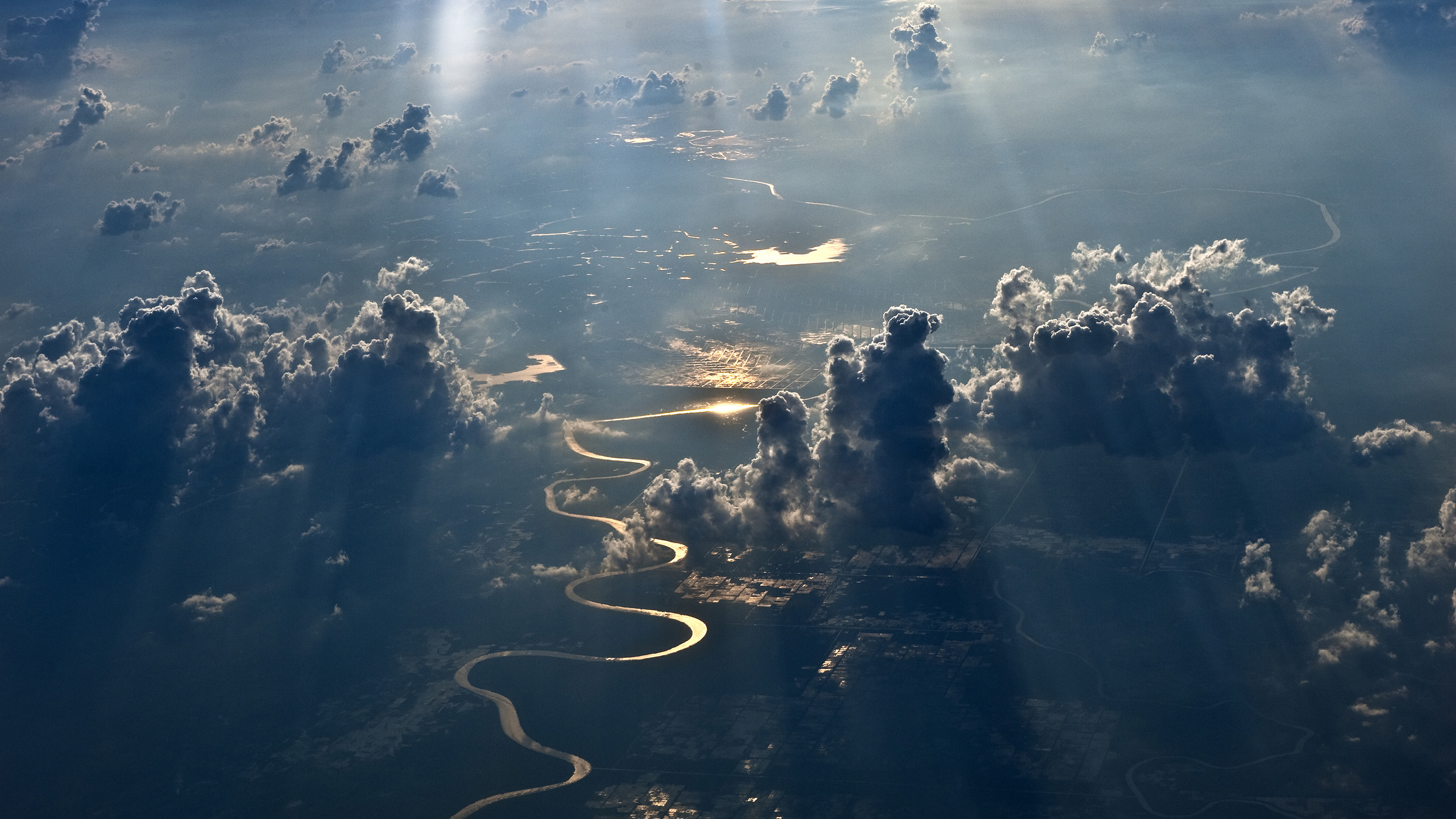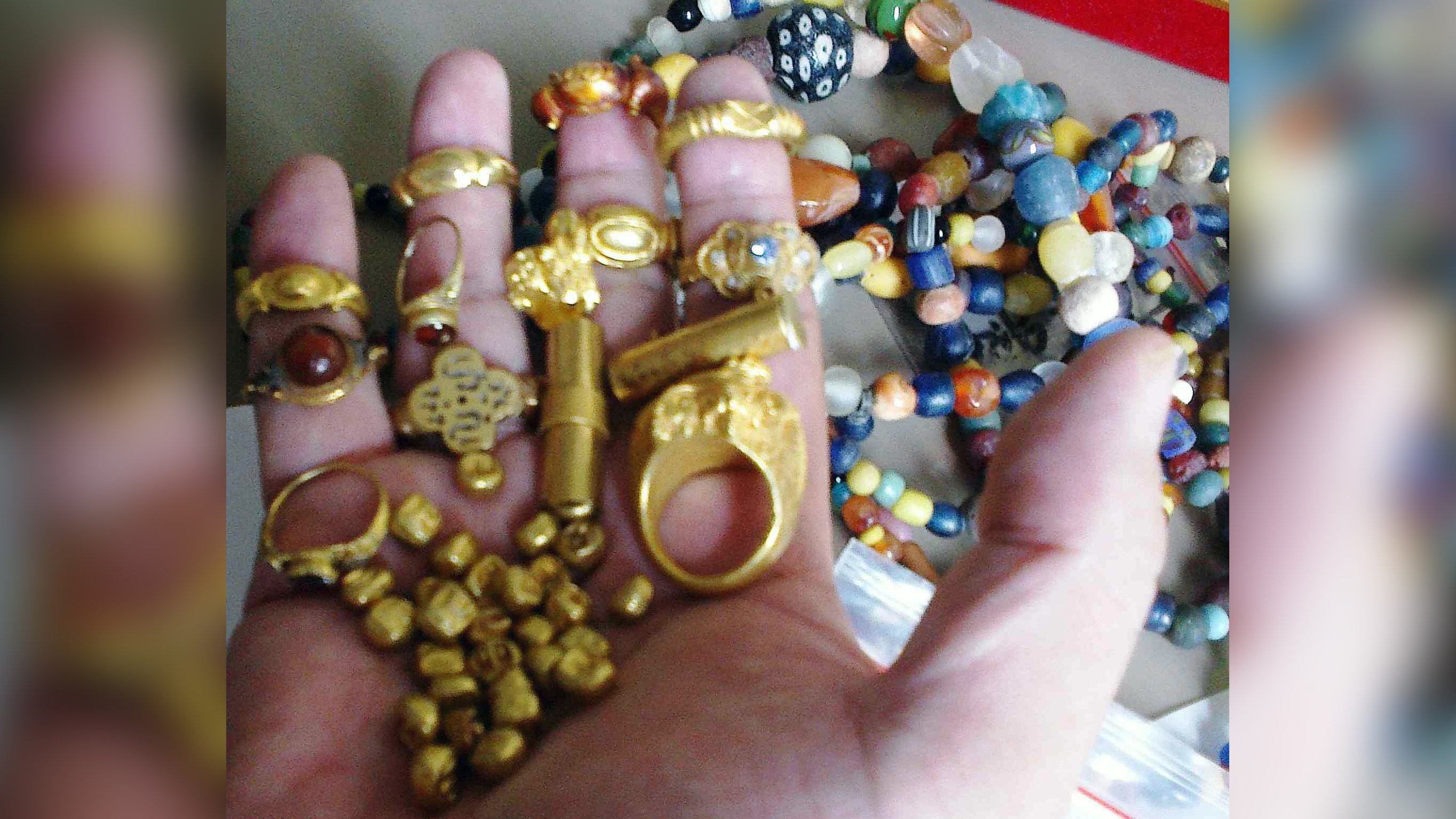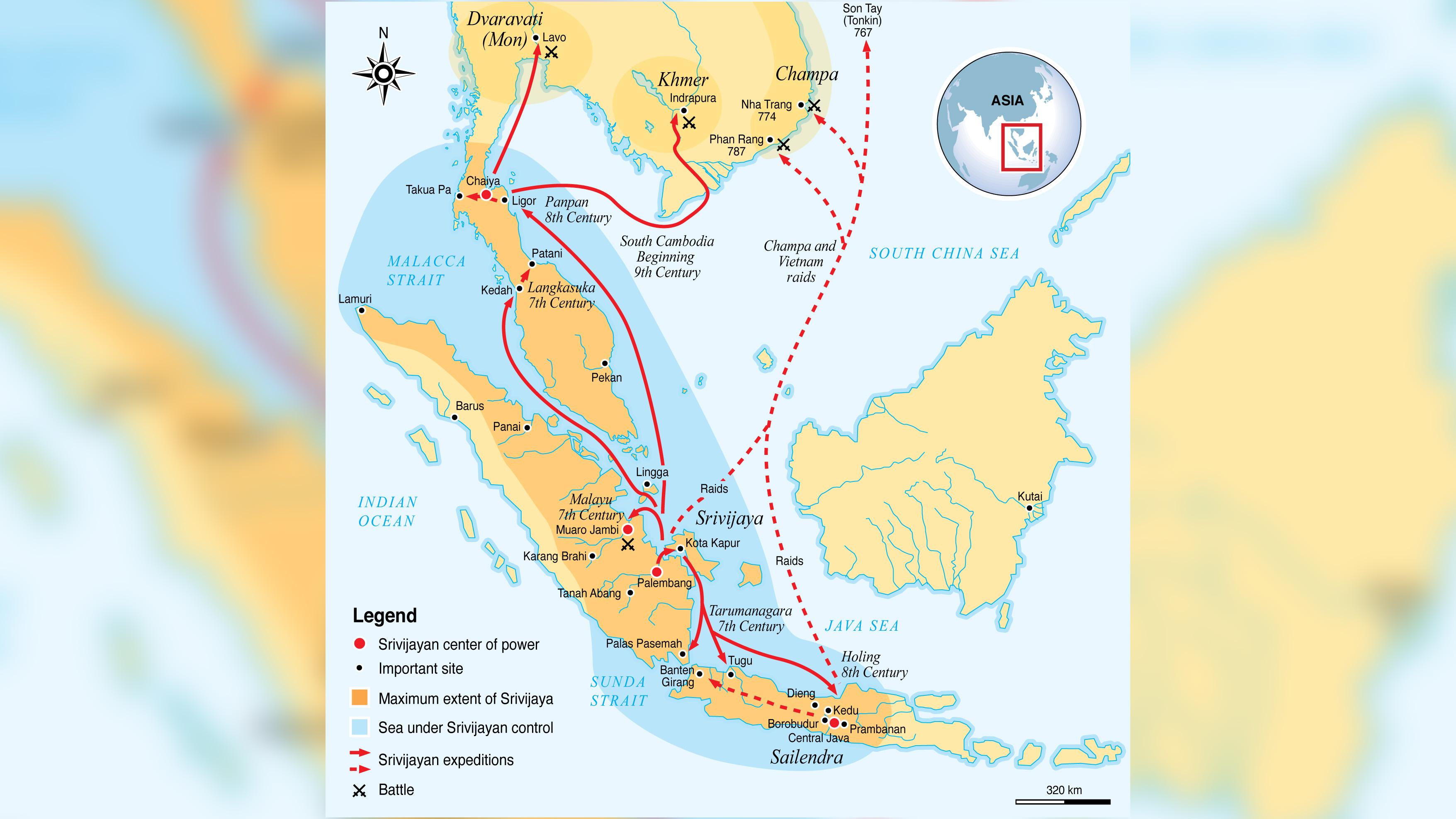Long-lost 'Island of Gold' resurfaces in Indonesian river
Artifacts found on the river bottom include golden rings, Buddhist statues and Chinese ceramics.

The remnants of the long-lost "Island of Gold" — where tales describe man-eating snakes, fire-belching volcanoes and Hindi-speaking parrots — may have been found in the Musi River near Palembang, Indonesia. And of course, there is gold, oozing from the river bottom.
Divers probing the muddy river bottom have hauled up hundreds of figurines, temple bells, tools, mirrors, coins and ceramics. They have found golden sword hilts and gold-and-ruby rings, carved jars and wine jugs and flutes shaped like peacocks.
These treasures all point to one thing: Scientists have located the lost city of Srivijaya, once a wealthy and powerful port along the ocean trade route between East and West. Srivijaya, which was ruled by a king, controlled the Straits of Malacca between the mid-600s and 1025, when war with the Indian Chola dynasty broke the city's power. From then on, Srivijaya declined in influence, though trading there continued for another two centuries, according to historians. The last Srivijayan prince, Parameswara, attempted to regain control of trade in the region in the 1390s, but he was soundly defeated by forces from the nearby kingdom of Java; afterward, Srivijaya and its surroundings became a haven for Chinese pirates.
Related: 30 of the world's most valuable treasures that are still missing

Today, almost no traces are left of the glory days of Srivijaya, save the glittering artifacts that divers have pulled from the river. No official archaeological excavations have ever been conducted in or around the river; artifacts are sold to private collectors on the global antiquities market. That means that even as artifacts resurface, finally pointing to the location of Srivijaya, there is hardly any physical evidence of what daily life was like there, said Sean Kingsley, a marine archaeologist and editor of Wreckwatch magazine, where he recently wrote about the lost Isle of Gold.
"We're starting at ground zero," Kingsley told Live Science. "It's like walking into a museum wing, and it's completely empty. People don't know what clothes the people of Srivijaya wore, what their tastes were, what kind of ceramics they liked to eat off, nothing. We don't know anything about them in life or in death."
Waterworld
Previous archaeological research around Palembang, Indonesia, the modern Sumatran city near where Srivijaya once sat, had turned up only small hints of the once-wealthy port: brick temples and a few inscriptions. Most of the information about the city comes from foreigners who wrote about their travels to Srivijaya. These merchants and visitors described a world that was "Lord of the Rings" meets J.K. Rowling's "Fantastic Beasts and Where to Find Them," Kingsley said. They wrote of volcanoes belching smoke and fire, man-eating snakes, parrots that could mimic Hindi, Greek and Arabic, and well-armed sailors willing to attack any vessel that tried to pass without entering Srivijaya. These accounts give a sense of the place, but are often sensationalized and reveal little about daily life in the port city.
Sign up for the Live Science daily newsletter now
Get the world’s most fascinating discoveries delivered straight to your inbox.
During the 10th century, Srivijaya's ruler paid to have Buddhist temples built in China and India, according to a 2006 report by French archaeologist Pierre-Yves Manguin. The city's tributes to China also hint at its wealth, both homegrown and acquired by trade: The city gave ivory, crystal statues, perfumes, pearls, coral and rhinoceros horn, according to a 2019 report published by the Australian National Centre of Excellence for Maritime Archaeology. Srivijaya had vastly rich local natural resources, Kingsley said, including desirable plants such as sandalwood and camphor. And then there was gold — naturally occurring deposits of it, eroding out in the Musi River.
Related: 7 bizarre ancient cultures that history forgot

How could such a wealthy civilization vanish with nary a trace? One likely possibility is that Srivijaya was made up mostly of wooden structures built right on top of the river. This water-world style of architecture is still seen on some rivers in Southeast Asia today. Houses are constructed on rafts and lashed together into a kind of floating city. Most of Srijivaya's structures would thus have rotted within a few generations, Kingsley said, leaving behind perhaps a few posts and stumps.
It's also possible that a geological event, perhaps related to Sumatra's volcanic activity, could have buried the site of Srivijaya, Kingsley said.
The disappearance of Srivijaya
The signs that the Musi River might hold the secrets of Srivijaya first emerged in 2011, when construction workers began to dredge sand from the Musi for large construction projects. Glittering artifacts appeared with the sand, leading many local workers and fishermen to moonlight as divers, using hoses attached to compressed air tanks to breathe as they probed the river bottom with iron rods. This amateur method often caused damage to more fragile artifacts, such as porcelain, wrote John Miksic, a professor of Southeast Asian studies at the National University of Singapore, in a paper presented in 2012 at the conference of the European Association of Southeast Asian Archeologists. Artifacts included bronze statues of Buddha, glass beads, stamps used to imprint words on clay, and scale weights probably used by merchants, according to a 2012 newsletter article by Miksic.
Between 2011 and 2015, a huge number of artifacts likely dating to Srivijaya's heyday appeared on the antiquities market in Jakarta, according to the 2019 Australian report. These were the most valuable of the Musi River discoveries, Miksic wrote in 2012 — objects with less commercial value were sold locally around Palembang.
"I think the looting is probably still in progress," Miksic wrote in an email to Live Science. "The river is broad (1 km [0.6 miles] wide) in Palembang. Similar activity has been reported in the Batanghari in Jambi, the next big river north of Palembang."
Selling off objects piecemeal strips them of context, making them hard to study. But in the absence of a systematic academic or government effort to protect the site, some artifacts were bought up by dedicated collectors who attempted to keep them together. The 2019 Australian report focuses on the ceramics collection of an Australian couple, Darrell John Kitchener and Heny Kustiarsih. The ceramics tell a story of close ties to China, with Chinese pottery dating to as early as the 800s and as late as the 1800s found in the river.
There are major barriers to a systematic excavation of the Musi River, Kingsley said. Indonesia took international criticism in the early 2000s after two major ninth- and 10th-century shipwrecks were discovered and sold. The first, the Belitung wreck, discovered in 1998, ended up safely in the hands of the Asian Civilizations Museum in Singapore, but the artifacts from the second, known as the Cirebon wreck, were put up for auction by the Indonesian government. Alarmed archaeologists called for the artifacts to be kept together. In response to the backlash, the government kept about 10% of the artifacts and issued a moratorium on underwater archaeology in 2010. (No one is sure how many of those saved artifacts are still in the country, Kingsley said.)
The moratorium and general lack of resources devoted to cultural heritage in Indonesia means that an official archaeological survey in the Musi would be tough. Unfortunately, the moratorium hasn't protected the Musi River artifacts, Kingsley said.
"Fishermen don't stop fishing and they don't stop discovering," he said. "Only now, they're even more unlikely to report finds to authorities. So underwater archaeology goes underground, and the black market thrives."
It might not be too late for the government or a wealthy collector to step in and buy up artifacts for museum display, Kingsley said, preserving the last remnants of this vanished world of wealth and luxury for everyone.
"This is the last great lost civilization that no one's heard about," Kingsley said. "There's an obligation to save it from oblivion."
Originally published on Live Science.

Stephanie Pappas is a contributing writer for Live Science, covering topics ranging from geoscience to archaeology to the human brain and behavior. She was previously a senior writer for Live Science but is now a freelancer based in Denver, Colorado, and regularly contributes to Scientific American and The Monitor, the monthly magazine of the American Psychological Association. Stephanie received a bachelor's degree in psychology from the University of South Carolina and a graduate certificate in science communication from the University of California, Santa Cruz.










